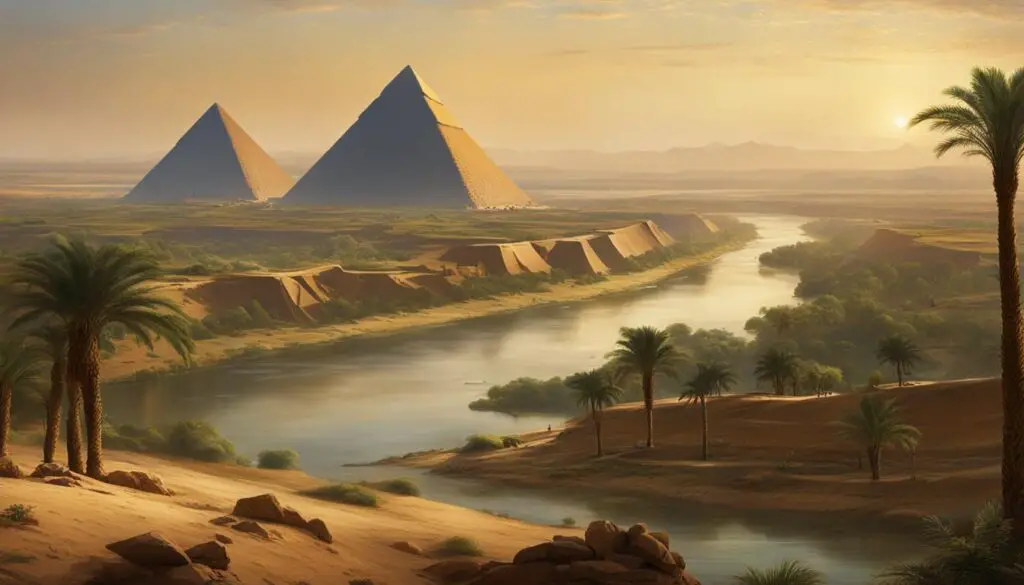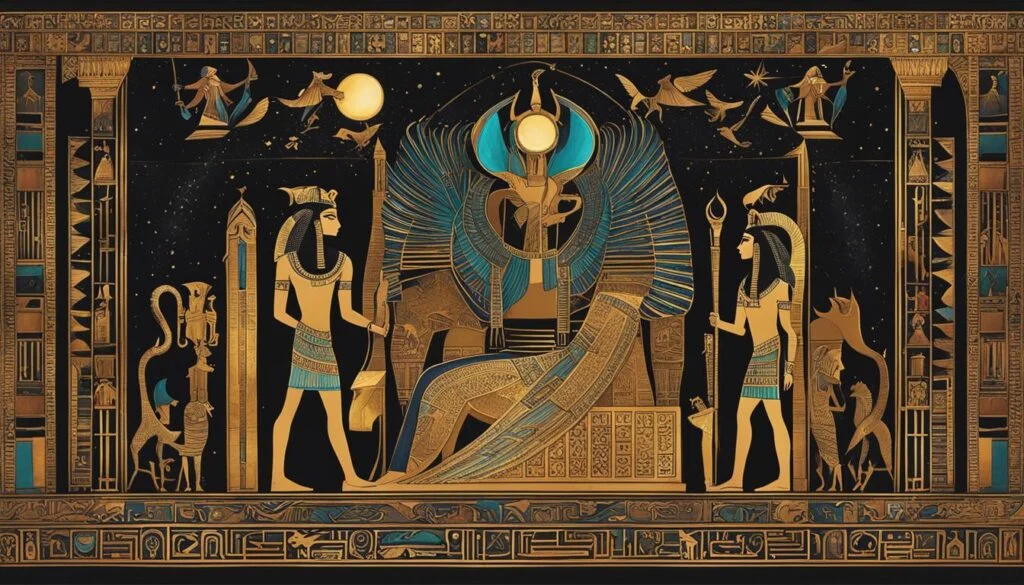Welcome to our article exploring the fascinating role of the Nile River in Egyptian mythology.
In ancient Egypt, the Nile was not just a lifeline for the people, but a symbol of profound significance and deep symbolism. Let’s dive into the rich mythology and explore the hidden meanings behind this iconic river.
For the ancient Egyptians, the Nile River held immense importance. It was believed to be a gift from the gods, equated with life itself. The rise and fall of its waters determined the calendar and influenced daily life.
The Nile River also played a central role in creation myths, such as the myth of Osiris, symbolizing death and rebirth. The Nile’s flood brought prosperity and fertility, while its decline represented the cycle of life and resurrection.
Key Takeaways:
- The Nile River was seen as a gift from the gods and symbolized life in ancient Egyptian mythology.
- It influenced the Egyptian calendar and daily life through its fluctuating water level.
- The Nile played a role in creation myths and represented death, rebirth, and resurrection.
- Animals such as crocodiles held significant roles in Nile mythology, while gods like Ptah and the myth of Osiris and Isis were closely tied to the river.
- The Nile’s influence extended to Egyptian architecture and temple design, shaping the beliefs and practices of ancient Egyptians.
The Creation Myth and the Nile
The Nile River holds a central place in the creation myth of Egyptian mythology. According to ancient beliefs, the Nile had both a heavenly and earthly source, making Egypt an embodiment of the celestial realms.
The annual flooding of the Nile played a pivotal role in the mythology, transforming the entire region into a vast sea that symbolized the primordial ocean.
As the Nile flooded, it brought new life and vibrant green vegetation to the previously arid land.
This natural cycle of flood and receding water mirrored the cycle of death and rebirth, which became deeply ingrained in Egyptian beliefs.
This concept of rebirth was further reinforced by the observation that new life sprouted from the fertile soil left behind by the receding waters.
The Nile’s profound influence on the creation myth had a significant impact on the burial practices of ancient Egyptians.
The belief in an afterlife was closely tied to the observation of the Nile’s natural processes, leading to the construction of tombs and burial sites on the West bank of the river.
This positioning was symbolic, as the West was associated with the land of the dead and the journey to the afterlife.
The creation myth rooted in the Nile River persisted in Egyptian culture, shaping their understanding of life, death, and rebirth.
It was through this mythological lens that the Egyptians interpreted and navigated their world, finding solace and purpose in the cyclical nature of the Nile’s flood and the eternal renewal it represented.
Ptah, the God of Craftsmen
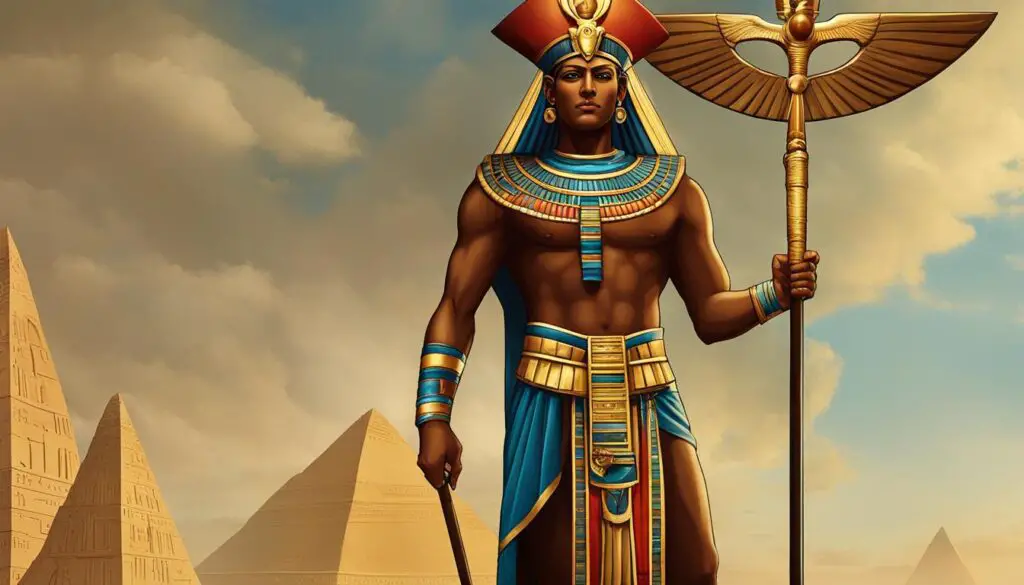
Within Egyptian mythology, Ptah held a prominent position as the god of craftsmen. He was intricately linked to the creation of life and the manifestation of the physical world through his words and thoughts.
Ptah’s creative abilities were revered, and he was often depicted holding symbolic objects that represented his dominion and divine power, such as the djed pillar, ankh, and was sceptre.
The symbolism associated with Ptah’s role in creation extended beyond the realm of crafts and artisans.
It encompassed the natural cycle of the Nile River, which served as a lifeline for ancient Egypt.
The annual flooding of the Nile brought fertile soil to the riverbanks, nurturing the growth of crops and sustaining the agricultural practices that were crucial to the prosperity of the civilization.
By associating Ptah with the natural cycle of the Nile, the ancient Egyptians emphasized the interconnectedness of the physical world, fertile land, and the celestial domain of the gods.
Ptah’s divine influence ensured the continuity of life and the harmonious balance between the different realms of existence.
The Myth of Osiris and Isis
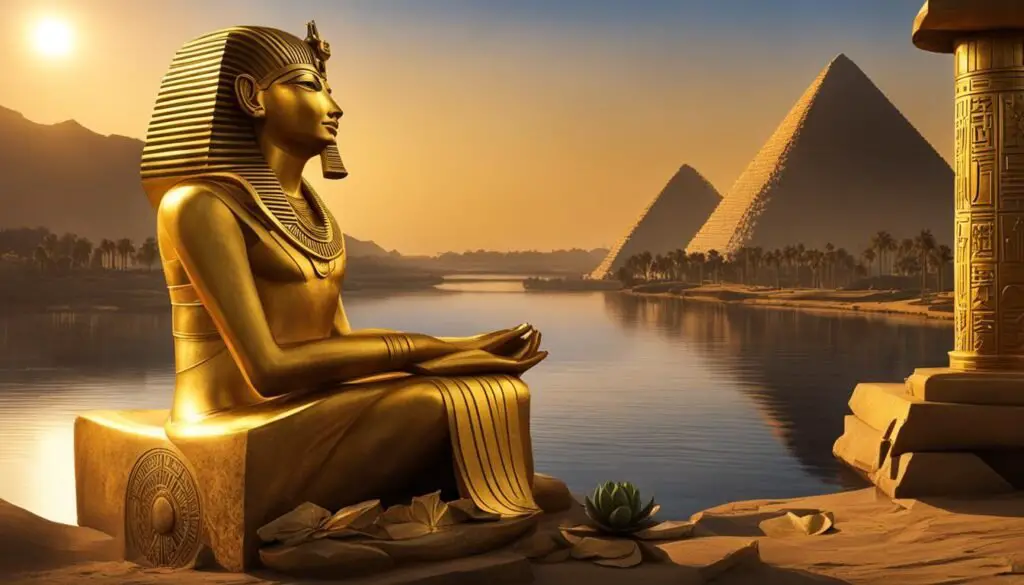
The myth of Osiris and Isis is considered one of the most renowned stories in Egyptian mythology, closely intertwined with the mystical Nile River.
Osiris, the revered king of Egypt, fell victim to his envious brother Seth, who dismembered his body and cast the pieces into the sacred waters of the Nile.
Guided by the river’s current, Osiris’ fragmented remains drifted until they reached the Mediterranean Sea.
It was here that Isis, the devoted wife of Osiris and powerful goddess of magic, discovered the scattered remnants of her husband’s body.
With unwavering determination and her unparalleled sorcery, Isis meticulously reconstructed Osiris, restoring him to life.
In their eternal love and union, Isis and Osiris conceived their son, Horus, who would later become a prominent figure in Egyptian mythology.
The profound tale of Osiris and Isis became intricately linked to the ebb and flow of the Nile’s waters, embodying the cyclical pattern of existence encompassing life, death, and rebirth.
The annual flooding of the Nile, which nourished the land and brought forth new growth, symbolized the resurrection and rejuvenation demonstrated by Osiris.
As the Nile receded and revealed the fertile soil, this represented the return of life after the deathly drought of the river.
Thus, the myth of Osiris and Isis captured the essence of the Nile’s vital role in sustaining and renewing life, extending its significance to the core of Egyptian culture and spirituality.
The Role of Nile Animals in Mythology

Several animals that inhabit the Nile River held significant roles in Egyptian mythology.
One of the most prominent and revered creatures was the crocodile, symbolized by the god Sobek.
As both a feared predator and a source of protection, Sobek played a dual role in ancient Egyptian beliefs.
By worshiping Sobek, Egyptians sought protection from animal attacks and evil in general.
Additionally, other Nile animals such as certain fish and birds held symbolic importance.
These creatures were associated with abundance, sustenance, and the concept of rebirth in the afterlife.
The ancient Egyptians recognized the vital role of the Nile and its animal inhabitants in sustaining their civilization.
The worship of Nile animals reflected the deep connection between the ancient Egyptians and the natural world.
They recognized their dependence on the river for survival and understood the significance of these creatures as symbols of the cycle of life.
The Nile’s Influence on Daily Life
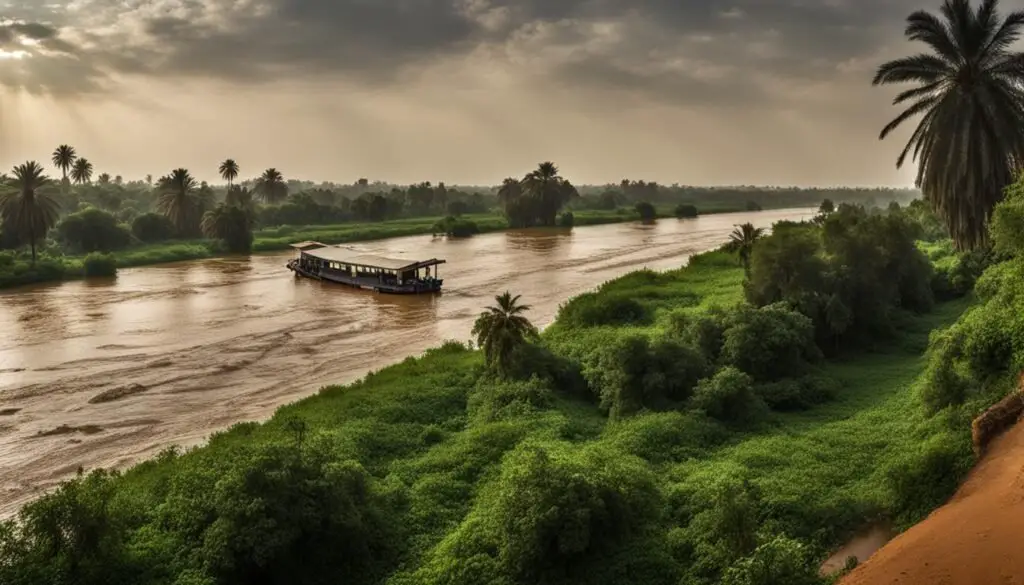
The Nile River played a crucial role in shaping the daily lives of ancient Egyptians. The annual flood of the Nile marked the beginning of the Egyptian calendar and had a profound impact on the prosperity and fertility of the land.
Each year, the flood season coincided with the appearance of the brightest star Sirius, heralding the start of a new year.
This event not only served as a reliable marker of time but also signaled the beginning of a period of abundance and growth.
When the Nile flooded, it left behind a rich layer of silt that made the surrounding land incredibly fertile.
The flooding provided essential nutrients for crops, ensuring bountiful harvests and the prosperity of the people.
However, the Nile’s fluctuating water levels were not without risks. If the water level rose too much, it could result in destructive floods that could destroy homes and crops.
On the other hand, if the water level did not rise enough, it could lead to drought and famine.
The Nile River’s control over the cycles of life and the agricultural practices of ancient Egypt shaped their cultural beliefs and practices.
It fostered a deep reverence for the river and a reliance on its ability to provide sustenance and abundance.
Key Points:
- ✅ The annual flood of the Nile marked the beginning of the Egyptian calendar.
- ✅ The Nile’s flood brought prosperity and fertility to the land, ensuring abundant harvests.
- ✅ Fluctuating water levels posed risks of destructive floods and drought.
- ✅ Ancient Egyptians revered and relied on the Nile for their livelihood and survival.
The Gods of the Nile
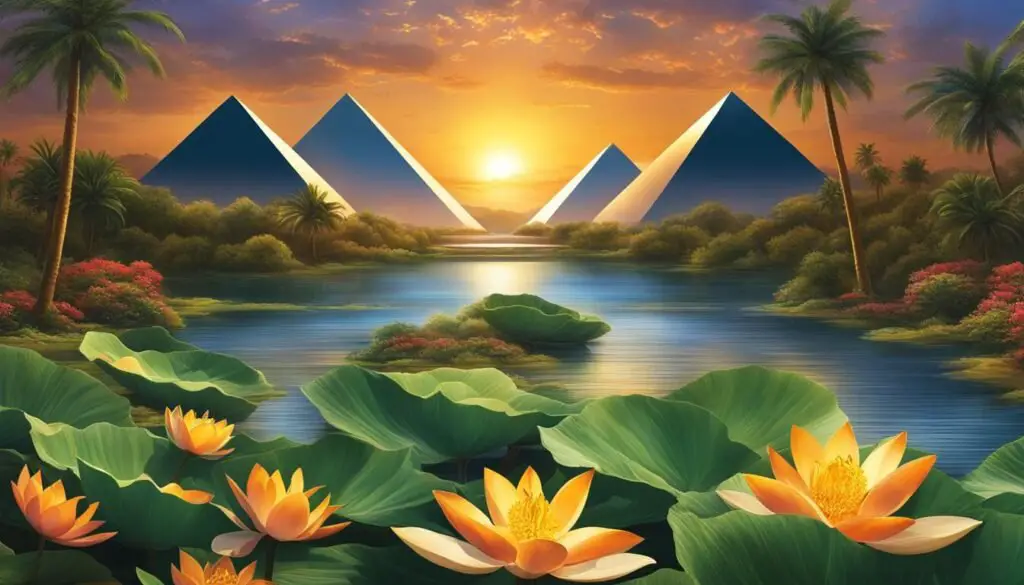
The Nile River holds a significant place in Egyptian mythology, and two gods, Khnum and Hapi, were revered as its guardians.
Khnum, the ram-headed god, was considered the lord of the water and the creator of life.
Worshiped on Elephantine Island and at his temple in Esna, Khnum brought fertility to the riverbanks, ensuring the prosperity of the surrounding lands.
Another prominent deity associated with the Nile is Hapi, an androgynous figure representing both genders.
Hapi symbolized the fertility and abundance brought by the annual flood of the Nile.
This flood was essential for the fertility of the land, ensuring bountiful harvests and a prosperous life for the ancient Egyptians.
The worship of Khnum and Hapi allowed the people to express their gratitude and seek blessings for a fruitful existence.
The Nile’s Influence on Egyptian Architecture

The myths and symbolism associated with the Nile River had a profound impact on Egyptian architecture, particularly in temple design.
Temples like Karnak and Abydos incorporated representations of the sun god Re and other deities, combining them with the essence of the Nile and its myths.
These architectural marvels depicted the various forms of the sun throughout the day, emphasizing its significance in Egyptian mythology.
Symbolism played a crucial role in the architectural elements of these temples. One commonly used symbol was the scarab beetle, representing the rising sun and the cycle of life, death, and rebirth.
Another significant symbol was the ostrich feather of Ma’at, symbolizing order and truth, integral aspects of Egyptian mythology.
The use of these symbols in temple designs helped convey the cultural and religious beliefs of ancient Egyptians.
The pharaoh and priests held central roles in temple rituals, as they were believed to have direct access to the sun god Re.
Through their connection to Re, they upheld the principles of order and truth that were deeply intertwined with the Nile’s mythology.
From the intricately carved hieroglyphs to the grand scale of these structures, Egyptian architecture exhibited the influence of the Nile and its myths in every detail.
In essence, the temples along the Nile River embodied the rich symbolism and mythology surrounding the Nile.
They stand as lasting testaments to the ancient Egyptian civilization’s deep spiritual connection to the river and its significant role in shaping their beliefs and practices.
The Protection of Nile Heritage
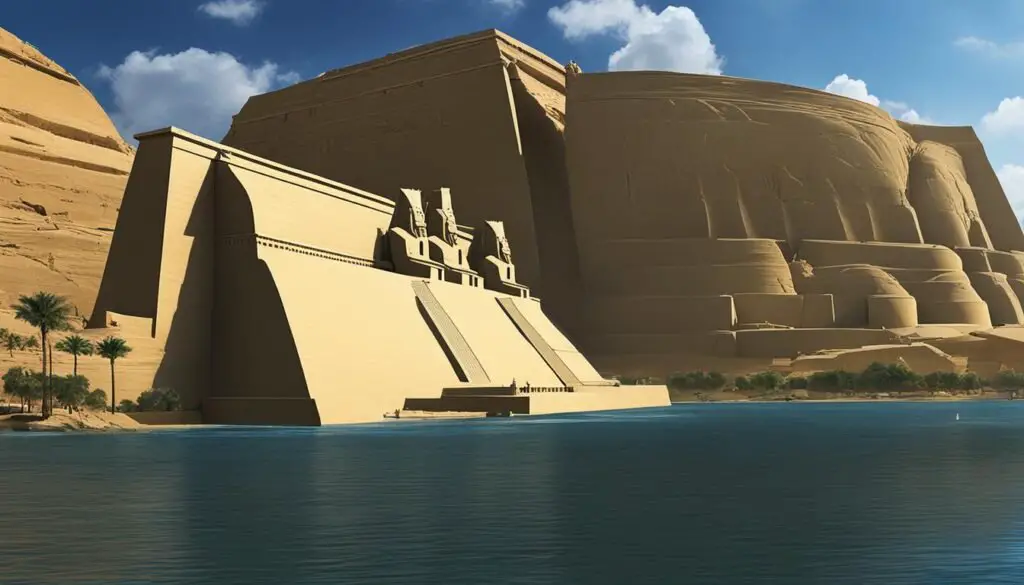
The construction of the High Dam in Aswan in 1954 posed a significant threat to the monumental temples of Abu Simbel and other Pharaonic treasures along the Nile.
In response to this alarming situation, Egypt and Sudan reached out to UNESCO for assistance in protecting these invaluable cultural heritage sites.
Recognizing the importance of preserving the rich mythology and historical significance associated with the Nile River and its surrounding landmarks, a massive effort was undertaken.
Thousands of scientists, engineers, experts, and workers joined forces to dismantle and relocate the temples of Abu Simbel to a safer location.
This monumental conservation effort ensured the safeguarding of these precious cultural sites.
By relocating the temples, the mythology and history embodied within them were preserved for future generations to appreciate and understand.
- The construction of the High Dam in Aswan in 1954 posed a threat to the monumental temples of Abu Simbel and other Pharaonic treasures.
. - Egypt and Sudan sought assistance from UNESCO to protect these cultural heritage sites.
. - Through a massive effort involving thousands of experts and workers, the temples of Abu Simbel were dismantled and relocated.
. - This conservation effort has successfully preserved the rich mythology and historical importance associated with the Nile River and its surrounding landmarks.
Exploring the Nile’s Mythology Today
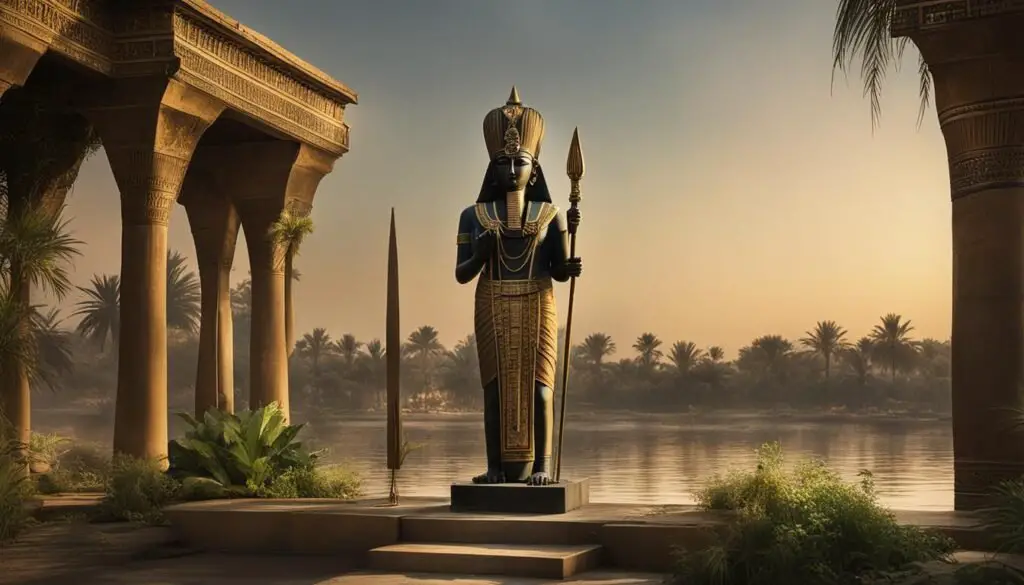
Every year, countless tourists flock to Egypt in search of the mystical allure of the Nile River and to uncover the secrets of its enigmatic sites.
Journeying through historical landmarks like the Temple of Ptah in Esna, the Temple of Horus in Edfu, the Kom Ombo Temple dedicated to Sobek, and the awe-inspiring temples of Karnak and Luxor, visitors are transported back in time to ancient Egypt.
These mythical sites offer more than just architectural marvels; they provide a window into the ancient stories and myths woven into the fabric of the Nile.
As travelers explore these ancient ruins, they are captivated by tales of gods, pharaohs, and epic battles, gaining insight into the rich cultural heritage that the Nile’s mythology offers.
For those seeking an even more immersive experience, embarking on a Nile cruise is the ideal way to connect with the river’s ancient stories.
As tourists traverse the tranquil waters, they have the opportunity to witness the reimagining of these myths through modern storytelling.
Expert guides and Egyptologists breathe life into age-old tales, sharing legends of creation, love, and conquest.
Whether standing in awe of the grandeur of Karnak or setting foot on the hallowed grounds of Luxor, exploring the Nile’s mythology is an unforgettable journey of discovery.
It allows tourists to delve into the captivating stories that have shaped Egypt’s cultural tapestry for millennia.
Unveiling the Secrets of the Nile
- Step into the Temple of Ptah, an oasis of spirituality where ancient rituals were performed to honor the god of craftsmen.
. - Visit the Temple of Horus, offering a glimpse into the extraordinary tales of the falcon-headed sky god and the adventures of pharaohs.
. - Immerse yourself in the Kom Ombo Temple, dedicated to Sobek, the crocodile god, and Horus the Elder, as you witness the intertwining of two powerful mythological figures.
. - Marvel at the temples of Karnak, where colossal statues and towering pillars bear witness to the grandeur of ancient Egypt and its gods.
. - Stand in awe at the temples of Luxor, the symbolic heart of Thebes, once home to magnificent palaces and temples.
As the sun sets on the Nile, travelers are left with lasting memories and a deeper appreciation for the ancient stories that still resonate in this mystical land.
Embarking on a quest to explore the mythology of the Nile River in modern times is a journey of enlightenment and discovery.
Tourists from all corners of the world continue to be drawn to Egypt to uncover the mysteries of the ancient stories that continue to captivate the imagination.
The Nile’s mythology, etched deep within the sands of time, invites visitors to step back in history and embark on a transformative adventure filled with wonder and awe.
Final Thoughts
The Nile River holds immense significance in Egyptian mythology, as it represents the cycle of life, creation, and death.
The ancient Egyptians deeply revered the Nile, considering it a sacred gift from the gods and a source of sustenance and prosperity.
The myths and symbolism surrounding the river reflected their strong connection to the natural world and their dependence on its annual flood for agricultural abundance.
Today, tourists have the opportunity to explore the remnants of this rich mythology by visiting the temples and historical sites along the banks of the Nile.
These cultural heritage sites, such as the Temple of Ptah, the magnificent Abu Simbel, or the grand temples of Karnak and Luxor, offer glimpses into the ancient stories and beliefs associated with the river.
Preserving and protecting these archaeological treasures is paramount in safeguarding the cultural heritage and mythology of the Nile River.
Efforts, such as the relocation of the temples of Abu Simbel, demonstrate the commitment to ensure that future generations can learn from and be captivated by the significance and symbolism embodied by the Nile.
As tourists continue to explore these ancient sites, the timeless mythology of the Nile will continue to inspire and educate visitors from around the world.
Frequently Asked Questions
Q: Why is the Nile river important in Egyptian mythology?
A: In Egyptian mythology, the Nile River was considered the source of life. It was believed to be a divine gift, providing water, food, and transportation. It also played a significant role in religious beliefs and rituals.
Q: What does the Nile river symbolize?
A: The Nile River symbolizes fertility, abundance, and renewal in Egyptian culture. It was seen as the sustainer of life, due to its annual flooding that deposited fertile soil along its banks, allowing for agriculture.
Q: What is the Nile in Egyptian culture?
A: In Egyptian culture, the Nile River is central to its identity and civilization. It was the main source of water, a vital element for agriculture and survival in the desert landscape. The Nile also influenced many aspects of ancient Egyptian society, including their calendar and agricultural practices.
Q: What did god say about the Nile river?
A: In Egyptian mythology, several gods were associated with the Nile, but there’s no specific reference to what a god said about the Nile. The river was often regarded as a divine entity itself or blessed by the gods.
Q: Is the Nile river sacred?
A: Yes, the Nile River was considered sacred in ancient Egypt. It was revered for its life-giving properties and was central to many religious beliefs and practices.
Q: Why is the Nile river called the gift of Egypt?
A: The Nile River is called the “gift of Egypt” because its annual flooding provided the fertile soil that enabled the Egyptians to grow crops and sustain their civilization in the surrounding desert.
Q: Why is Osiris associated with the Nile?
A: Osiris, the god of the afterlife, resurrection, and fertility, is associated with the Nile due to the river’s life-giving and sustaining properties. The flooding of the Nile was also likened to the tears of Isis for Osiris, bringing life back to the land.
Q: What river did god turn into blood?
A: In the biblical story of Exodus, it is recounted that God, through Moses, turned the Nile River into blood as the first of the Ten Plagues of Egypt.


